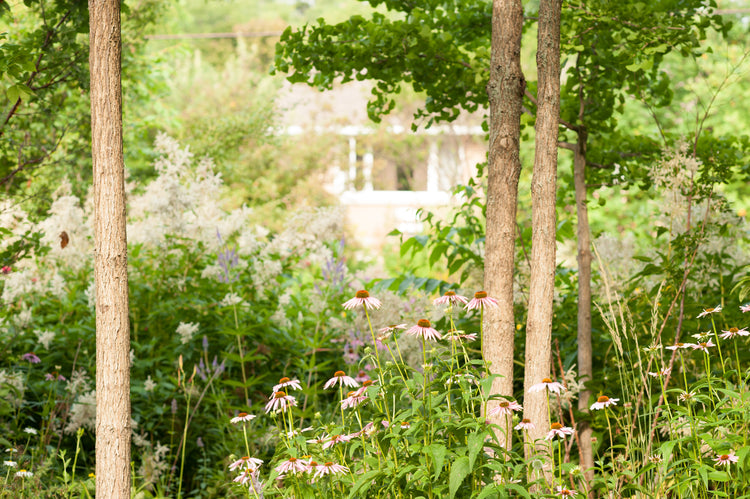Why plant a tree when you can plant a forest?

Imagine the incredible life and beauty of a pocket forest through the seasons. Spring buds opening. Pollinators fueling up. Birds celebrating sunrise. Leaves rustling. Babies being fed insects. Mining bees laying eggs in stumps. Birds fueling up on berries during fall migration. Sunset heightening incredible fall colours. Winter frosts clinging to branches.
Pocket forests give the land a chance to heal, as we regenerate life in our city. A pocket forest brings the magic of Nature to your doorstep, attracting birds, pollinators, insects, and other wildlife, and with them a riot of colour, sound, and smells.
Get to know the land
What (and who) are there now?
- Sit quietly. Listen. Watch. Who visits? How does the sun move? What sounds do you hear?
- How does the water flow during a heavy rain? Is there a slope?
- Are there microclimates (areas protected from the wind)? Is there underground or above ground infrastructure?
- What is the soil like (texture, depth, health)? Do a simple soil texture test.
- Are there already trees in your yard or nearby? If so, what species? Invasive Norway Maple makes it more challenging to plant a pocket forest.
- Look out of your favourite window and dream of what and who you might want view throughout the seasons.
- Explore a nearby forest for inspiration.
Consider your goals

Image: Deanna Lynn, Landscape Design for Carbon Sequestration
Your goals may impact your design. For example, if you're interested in cooling your home you'll want to locate your pocket forest on the southwest side of your home. If you'd like to create a sanctuary by in your front yard, you'll want to lay out your pocket forest to surround your sitting area. Your goals will also influence which Pocket Forest Kit you choose. Possible goals include:
- Take action on the climate crisis by sinking carbon.
- Make the neighbourhood more climate resilient by helping cool your home, creating a windbreak, sinking and absorbing rainwater.
- Helps trees migrate so forests can adapt to new climatic conditions.
- Help reverse the biodiversity crisis threatening pollinators, birds and insects.
- Increase your own and your neighbourhood’s wellbeing.
- Enjoy the beauty of trees (flowers, berries, fall colour, winter architecture) and their many visitors (birds, pollinators, insects and more).
- Increase privacy and reduce noise.
- Improve air quality by removing pollutants from the air (sulphur dioxide, nitrogen dioxide, and fine particulate matter).
Outline the shape
- Use a garden hose or piece of rope to outline the shape of the forest, mark out paths and lay any clearings. Your pocket forest can be as small as 3 square metres. If you have space, you can plant more than one pocket forest.
- Create one or more paths that lead you to a special place in, near or around the pocket forest – a pond, a bench, a sitting stump.
- Consider connecting your pocket forest to a clearing where you can linger, relax and gather with friends and family.
- Use neighbouring trees as part of a borrowed landscape and as an upper canopy.
- You could also shape the earth to slow, spread, and absorb rain by digging swales (low spots) and using the soil to create mounds, bringing back the natural topography of a forest floor
Choose the forest community

Image: LA Micro Forests
Forests are naturally diverse. Cooperative processes such as mutual shading, symbiotic nitrogen fixation, accelerated nutrient cycling, abundance & composition of mycorrhizae, water interactions, pest and disease resistance, resilience to climate change, and light interactions prevail.
- Canopy layer: Don’t be afraid of trees who grow big! You’ll enjoy the wildlife they attract during their infancy and teenage years, canopy dwelling birds will find a home, and your grandchildren and great grandchildren will enjoy their full magnificence.
- Understory layer: Understory trees grow quickly, gifting birds, bees (and you!) with flowers and berries.
- Shrub layer: Shrubs establish quickly, increasing biodiversity, offering shelter and nest sites for birds, nectar and pollen for pollinators, and berries for you or the birds.
- Ground layer: Protecting the soil is critical to building the microbial life necessary for thriving forest. For the first couple of years, mulch with a thick layer of leaves, straw, or woodchips. Plant a ground layer of native perennials, sedges and grasses which knit together within a few years to form a living green mulch.
Increase habitat

Rather than buying garden art, create your own with natural materials that also offer habitat to increase the biodiversity in your forest.
- stumps
- logs
- stones or boulders
- water (natural pond, container pond, bubble fountain, bird bath)
- dead hedge
- insect wall
- bird houses
Create a path

- Create a winding path using woodchips, gravel, stepping stones, pine needles, or ground hugging plants.
- Situate a plant, rock, stump or other architectural element where the path curves.
- Include places to pause and enjoy a feature such as a stump, a basin of water, a flowering shrub.
- If you’re planting several pocket forests, wind the path through them to encourage discovery.
- Plant a ground layer of native plants and sedges to enjoy as you walk the path.
- Include a bench, chair or stump along the path to sit and enjoy the birds when visiting your forest sanctuary
Each year your pocket forest will support more life, build healthier soil, and store more carbon. Within 15-25 years, your pocket forest will become a mother patch, with birds and other wildlife spreading the seeds to new locations. In 15-50 years, your pocket forest will weave together with many other pocket forests throughout the city to grow a city in a forest!

